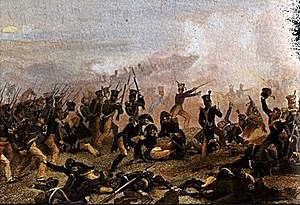Battle of Lundy's Lane
| date | July 25, 1814 |
|---|---|
| place | On a street ("Lundy's Lane") near the Niagara River in Canada |
| output | British victory |
| Parties to the conflict | |
|---|---|
| Commander | |
|
Sir Gordon Drummond |
|
| Troop strength | |
| 2,800 men | 2,900 men |
| losses | |
|
878 dead and wounded |
854 dead and wounded |
Theater of War St. Lawrence / Lake Champlain 1. Sacket's Harbor - 1. Lacolle Mills - Lake Ontario - Ogdensburg - New York - 2. Sacket's Harbor - Châteauguay - Chrysler's Farm - 2. Lacolle Mills - Fort Oswego - Big Sandy Creek - Plattsburgh
Niagara Theater of War
Queenston Heights - Frenchman's Creek - George - Stoney Creek - Beaver Dams - Black Rock - Fort Niagara - Buffalo - 1st Fort Erie - Chippewa - Lundy's Lane - 2nd Fort Erie - Cook's Mill
Detroit
Theater of War Tippecanoe - Fort Mackinac - Dearborn - Detroit - Fort Harrison - Fort Wayne - Wild Cat Creek - Mississinewa - Frenchtown - Fort Meigs - Fort Stephenson - Lake Erie - Thames River - Longwoods - Prarie du Chien - Rock Island Rapids - Mackinac Island - Malcom's Mills
Chesapeake
Theater of War Craney Island - St. Michaels - Chesapeake - Bladensburg - Washington - Caulk's Field - North Point - Baltimore
South Theater of War
Creek - 1. Fort Bowyer - Fayal - Pensacola - Lake Borgnes - New Orleans - Fort St. Philip - Fort Peter - 2. Fort Bowyer
The Battle of Lundy's Lane on July 25, 1814 between the British and the Americans took place near the Niagara River in Canada during the British-American War and ended tactically without a clear victory, but strategically a British success.
course
At the beginning of July 1813, American troops under General Jacob Brown (1775-1828) advanced across the Niagara River to Canada after several unsuccessful attempts to invade Canada. On July 3, the border fortress Fort Erie was captured , and on July 5, an American brigade under Brigadier General Winfield Scott won the battle of Chippewa over a British contingent under Sir Phineas Riall . After this victory, Brown advanced with his troops on Queenston ( Ontario ), but gave up the attack because he did not receive sufficient support from the US fleet on Lake Ontario under Commodore Isaac Chauncey . Brown then withdrew to Chippewa, and from there overland to advance to the western end of Lake Ontario. However, the British had gathered 2,200 soldiers at Lundy's Lane and 1,500 others at Fort George and Fort Niagara . During a reconnaissance mission on the afternoon of July 25th at Lundy's Lane , Scott's brigade accidentally came across British troops, about 1,000 men under Sir Phineas Riall, who were positioned on the ridge of a hill and were covered by a cleverly placed gun battery. Gradually, both Brown's entire army (2,900 men) and the nearby British troops, a total of about 2,800 men under Lieutenant General Sir Gordon Drummond , intervened in the battle. The Americans attacked over open, fenced terrain and were thrown back with heavy losses. Brown made the mistake of sending his troops into battle one by one instead of leading a mass attack. Scott's brigade, in particular, suffered very heavy losses. The soldiers on both sides suffered badly from the great heat and the gun smoke, which did not escape and severely restricted the view. After a series of loss-making attacks, the US troops under General Ripley succeeded in taking the British gun emplacement around 9 p.m. and inflicting heavy losses on the advancing British reinforcements through artillery fire from close range. The British undertook a series of loss-making counter attacks, in which there was often close combat. Due to the darkness and the smoke, there were always mix-ups and shootings between soldiers on their own side. Although Drummond's soldiers failed to get as far as the guns, they were able to take out the American gun crew. At midnight the Americans finally withdrew because their lines of communication were overstretched and they had suffered too great losses to hold the hilltop. The Americans were able to take one gun with them, the rest fell back into British hands. The exhausted British soldiers threw themselves on the ground where they had stood and slept among mountains of dead. Brown and Scott were wounded, as were Drummond, and Riall was taken prisoner by the Americans.
Results
The battle at Lundy's Lane was the bloodiest battle that has ever taken place on Canadian soil. The British complained of 878, the Americans 854 dead and wounded. Both sides claimed victory for themselves. The Americans had been unable to break through the British lines and clear the battlefield, but the British had only been able to occupy it because the Americans had withdrawn. Strategically, Lundy's Lane was a British success as the Americans called off their invasion and withdrew from Canada. Thus the last realistic possibility of achieving the war goal of conquering Canada failed, as the British now received more reinforcements from Europe after the end of the fighting against Napoleon . The US troops were able to successfully pass a siege of Fort Erie (until September 21 ), but gave up the border fortress and with it their last conquest on Canadian soil on November 5 .
See also
Web links
- Friends of the Lundy's Lane Battlefield (Engl.)
- Gala film: Battle of Lundy's Lane ( Memento from October 12, 2014 in the Internet Archive )
- Pictorial Field Book of the war of 1812
